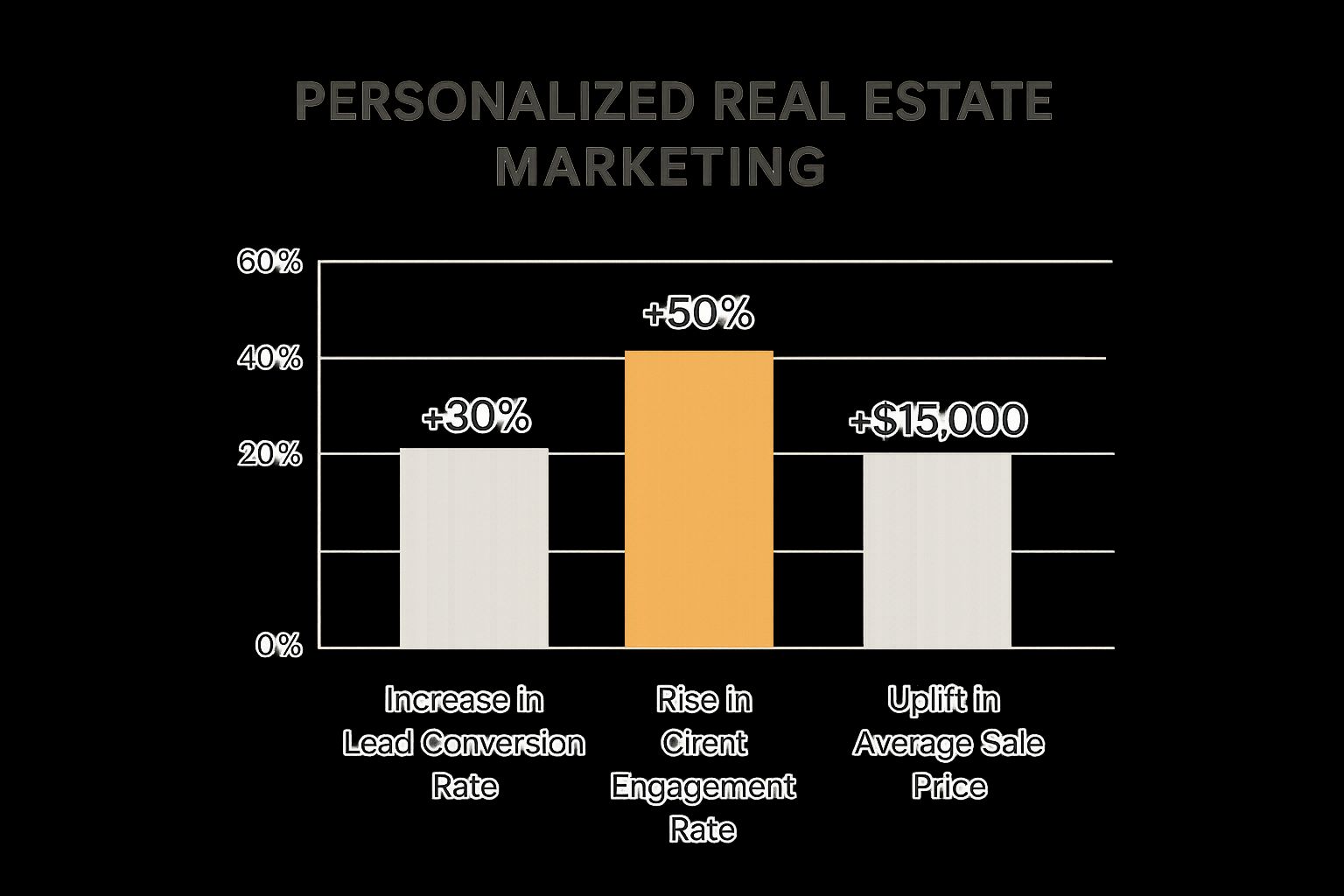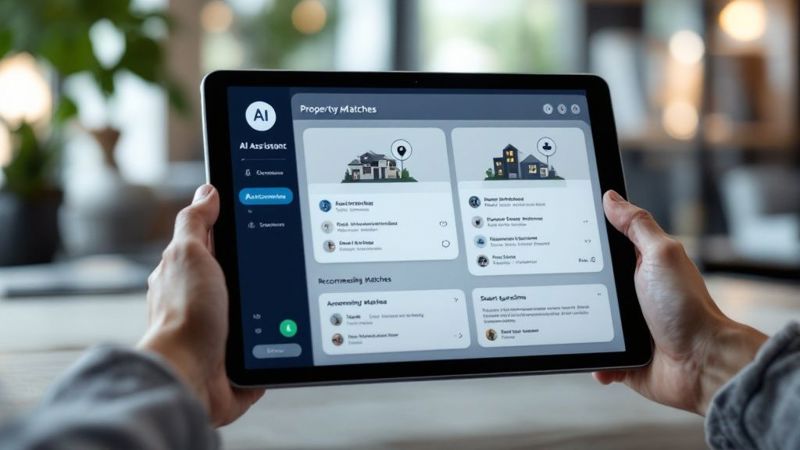Why Personalization Is Revolutionizing Real Estate Success
The real estate market is constantly changing. The old days of generic property listings and one-size-fits-all marketing are fading fast. Today, personalization is the key to success for real estate professionals. This individualized approach isn't just a passing trend; it's a fundamental shift in how agents connect with clients and close deals.
Understanding the Shift in Buyer Expectations
This transformation is fueled by changing buyer expectations. Clients now want tailored experiences that meet their specific needs and goals. They aren't just searching for a house; they're searching for a home that reflects their lifestyle and dreams. This requires agents to go beyond simply showcasing properties and adopt a more consultative, personalized approach.
For example, understanding if a client prefers a modern kitchen or a large backyard allows agents to present properties that truly resonate. Knowing their preferred school district or commute time allows agents to offer relevant information, simplifying the search. This shift from transactional interactions to meaningful relationships fosters client loyalty and generates referrals. You might be interested in: How to master personalized marketing.
The Power of Personalized Marketing
Personalization is effective because it connects with clients on a deeper level. When clients feel understood and valued, they're more likely to engage, trust, and ultimately, choose to work with an agent who recognizes their individuality. This is especially critical in today's world where consumers are constantly bombarded with generic advertising.
Personalized real estate marketing has become incredibly important, significantly influencing buyer choices. By 2025, 71% of buyers are expected to choose agents with a strong social media presence, emphasizing the importance of personalized online engagement. Personalized lead systems can boost sales by 20%, proving the effectiveness of tailored marketing. Find more statistics here: Real Estate Marketing Statistics. Real estate marketing as a whole is becoming increasingly personalized. This highlights the need for a personalized approach to build strong relationships and achieve lasting success.
Assessing Your Current Marketing Approach
To succeed in this new era, agents need to evaluate their current marketing strategies. Are you relying on generic email blasts and impersonal flyers? Or are you actively working to understand your clients' individual needs and tailoring your messages to resonate with their aspirations? Embracing personalization means understanding your target audience, using data-driven insights, and building genuine relationships.
Visual Storytelling That Sells Properties Lightning-Fast
In the competitive real estate market, captivating visuals are essential for attracting buyers and closing deals quickly. This isn't about simple snapshots; it's about crafting a visual narrative that resonates emotionally. Visual storytelling in real estate marketing uses high-quality photography, virtual staging, and video walkthroughs to create an immersive experience, letting potential buyers imagine themselves living in the property.
The Power of Professional Visuals
Professional photography is the foundation of effective visual storytelling. High-quality images showcase a property's best features, highlighting key selling points and creating a sense of desire. Virtual staging allows buyers to see a space's potential, even if unfurnished. Video walkthroughs offer a dynamic, engaging way to explore the property from home, providing a more realistic feel for space and flow.
This infographic highlights the impact of personalized real estate marketing:

Personalized marketing with strong visuals significantly improves lead conversion, client engagement, and sale prices. This demonstrates the impact of targeting specific buyer segments with tailored visual content. Families might be drawn to images of spacious backyards, while young professionals might prefer sleek interiors.
The following table further illustrates the impact of visual elements:
To understand the influence of professional visuals on property marketing, let's examine some key metrics. The table below compares the performance of properties marketed with standard visuals versus those with professionally enhanced content.
| Marketing Element | Industry Adoption Rate | Impact on Sale Time | Impact on Social Media Engagement | Effect on Final Sale Price |
|---|---|---|---|---|
| Professional Photography | 35% | 32% faster | 1,200% increase in shares | Significant Increase |
| Virtual Staging | Increasing | Reduces time on market | Boosts engagement | Positive Impact |
| Video Walkthroughs | Growing rapidly | Facilitates faster decisions | Drives higher viewership | Can lead to higher offers |
The table above demonstrates the significant advantages of incorporating professional visuals in real estate marketing. The data reveals that despite a relatively low adoption rate for professional photography, its impact on sale time and social media engagement is substantial. This reinforces the importance of investing in high-quality visuals. For more detailed statistics, check out: Key Real Estate Marketing Statistics for 2025.
Crafting a Consistent Visual Identity
While personalization is important, maintaining a consistent visual identity across marketing materials builds brand recognition. This means using consistent color palettes, fonts, and image styles for a cohesive, professional look. However, each listing should still be unique. Customizing imagery to emphasize specific features that appeal to each target audience ensures visuals are both attractive and relevant.
Budget-Conscious Approaches
Creating professional-quality visuals doesn't always require a huge budget. Investing in good lighting and basic Adobe Photoshop editing software can dramatically improve photo quality. Partnering with local photographers or videographers offering affordable packages is a cost-effective solution. By prioritizing visual storytelling, real estate agents can effectively connect with buyers, accelerate sales, and achieve lasting success.
Digital Personalization Tactics That Convert Cold Leads

Top real estate agents are moving beyond generic marketing and embracing digital personalization to turn cold leads into warm prospects. This involves blending AI-powered tools with authentic personal touches for effective scaling. Connect with more people without sacrificing genuine interaction.
Understanding Your Audience Through Segmentation
Effective personalized real estate marketing starts with understanding your audience. Audience segmentation is key. It's like organizing contacts into groups based on shared traits: demographics, lifestyle, property preferences, or even online behavior.
First-time homebuyers, for instance, have different needs than investors. Segmenting allows you to tailor content that resonates with each group. For more real estate marketing ideas, check out this helpful article: Real Estate Marketing Ideas.
Leveraging Behavioral Data for Anticipatory Marketing
Behavioral data offers valuable insights into client preferences. By tracking website activity, email engagement, and social media interactions, you can anticipate client needs.
This allows you to create personalized digital touchpoints that feel relevant, even at scale. Imagine sending property listings that perfectly match a client's previous views or offering neighborhood guides based on their interests. This sets you apart.
Implementing Personalized Digital Tactics
Here are some digital tactics to transform your real estate marketing:
- Personalized Email Campaigns: Create email newsletters with curated property listings based on individual preferences, relevant local market updates, and helpful resources tailored to their buying/selling stage.
- Targeted Social Media Advertising: Use platforms like Facebook or Instagram to target specific demographics with compelling visuals, testimonials, and video content.
- Dynamic Website Personalization: Develop dynamic landing pages that adjust content based on visitor behavior. If someone views luxury condos, the landing page can showcase similar listings.
- AI-Powered Chatbots: Use chatbots on your website and social media to instantly answer questions, offer personalized recommendations, and schedule consultations.
- Automated Follow-up Systems: Nurture leads with automated email sequences that deliver valuable information and maintain contact without constant manual effort.
Visual content is increasingly important in real estate marketing. For example, a well-crafted Video Case Study can significantly enhance engagement.
Measuring Success and ROI
Personalized digital tactics require investment, but the potential returns are significant. Track key performance indicators (KPIs) like lead conversion rates, client engagement, and sales to demonstrate the value of this approach.
It's not just about reaching more people; it's about reaching the right people with the right message at the right time. This builds trust, strengthens relationships, and drives conversions.
Blending Traditional & Digital Channels For Maximum Impact

The most effective personalized real estate marketing strategies recognize the power of combining digital and traditional methods. Instead of viewing them as separate entities, top agents are integrating them into multi-channel campaigns where each element complements the others. This creates a synergistic effect that resonates with clients.
Reinventing Traditional Approaches
Traditional methods like direct mail, print materials, and in-person networking still hold significant value. However, they become even more impactful when personalized and integrated with digital strategies. Imagine a personalized handwritten note following up on a digital property viewing – it adds a genuine, personal connection.
Similarly, hosting a neighborhood event and promoting it through social media platforms like Facebook and Instagram blends online reach with offline connection. This allows agents to connect with their community on a more personal level.
Even familiar tactics gain new life when viewed through this lens. This approach allows agents to remain competitive while leveraging proven methods.
Direct mail marketing, despite the rise of digital, continues to be a valuable tool. It offers a tangible connection that digital often lacks. The ROI of direct mail can be as high as 29%, underscoring its effectiveness.
However, with only 42.2% of recipients reading or scanning their mail, there's room for improvement. Adding QR codes to direct mail pieces, linking recipients directly to online listings, can enhance the experience. Explore more: Real Estate Marketing Statistics.
Coordinating Consistent Messaging
Consistent messaging is crucial for successful multi-channel marketing. Whether online, through direct mail, or at an event, your brand message should be consistent. This creates a unified and professional image, building trust and reinforcing your expertise.
Budget Allocation and Cross-Platform Measurement
Budget allocation across different channels requires careful planning. While digital marketing offers targeted results, don't underestimate traditional efforts. A balanced approach, aligning with your audience and goals, is essential.
Measuring cross-platform performance goes beyond basic metrics. It involves understanding how each channel influences the others and contributes to the client journey. For example, a tracked QR code on a direct mail piece reveals how offline efforts drive online engagement. This provides valuable insights for optimization.
Building a Cohesive Strategy
Here are some key steps for a cohesive multi-channel marketing plan:
- Define your target audience: Understand their preferred communication methods.
- Develop consistent messaging: Maintain a clear brand identity across all channels.
- Integrate online and offline efforts: Use digital tools to enhance traditional methods, and vice-versa.
- Track and measure performance: Analyze data to understand the client journey and optimize your strategy.
By strategically blending traditional and digital tactics, real estate agents can create effective personalized campaigns that connect with clients and achieve significant results.
Data-Driven Strategies For Hyper-Personalized Marketing
The future of real estate marketing relies on effectively using client data. This allows for hyper-personalized strategies that truly connect with individual buyers and sellers. Forget mass emails; this is about understanding each client's specific needs and tailoring communication to match.
Collecting and Analyzing Client Data
Data collection forms the bedrock of personalized marketing. Practical methods include using tools like Google Analytics for website data, CRM systems for managing client interactions, and even valuable insights gleaned from direct client conversations. These methods gather crucial information about client preferences, behaviors, and motivations.
Analyzing this data reveals important patterns and provides insights that shape effective marketing strategies. For instance, knowing a client prefers historic homes allows agents to present relevant listings and avoid sending information about modern condos.
You might be interested in learning more about efficient and targeted campaigns: How to master real estate marketing automation
Building Comprehensive Buyer Personas
Buyer personas delve deeper than simple demographics. They create a detailed portrait of the ideal client, encompassing motivations, pain points, and the factors that influence their decision-making.
This detailed understanding allows agents to craft content that speaks directly to these needs. Content for a first-time homebuyer might focus on navigating the mortgage process. In contrast, content for a seasoned investor might highlight market trends and ROI projections.
Using Data to Predict Preferences and Personalize Communication
Analyzing past behavior helps predict future preferences. If a client consistently clicks on listings with large backyards, this feature is likely a priority for them. Use this insight to further personalize communication.
This extends beyond property recommendations, influencing the type of content shared, the timing of communication, and even the client's preferred communication channels.
Accessible Tools and Techniques for Tracking and Optimization
Several tools facilitate effective data tracking and campaign optimization. Google Analytics provides insights into website traffic and user behavior. CRM systems, such as HubSpot, track client interactions and preferences.
These tools enable campaign performance monitoring in real-time. This allows for immediate adjustments based on what's working and what's not, instead of waiting until a campaign concludes.
Addressing Privacy Considerations and Ethical Data Collection
Data collection must be ethical and transparent. Openly communicate with clients about the data you collect and how it's used. Prioritize respecting privacy concerns and adhere to data protection regulations.
Building trust is crucial. Unethical data practices can damage client relationships and harm your reputation. Transparency builds confidence and strengthens the client-agent bond.
Essential Data Points for Real Estate Marketing Personalization
The following table details key data points for effective personalization in real estate marketing, providing a roadmap for collecting and utilizing this information ethically and effectively.
| Data Category | Specific Data Points | Personalization Applications | Collection Methods | Privacy Considerations |
|---|---|---|---|---|
| Demographics | Age, location, family size | Targeting relevant listings and content | Website forms, CRM systems | Ensure data is collected with explicit consent |
| Property Preferences | Style, features, budget | Tailoring property recommendations and marketing materials | Website activity, client surveys | Respect client privacy; avoid sharing data without permission |
| Financial Information | Mortgage pre-approval, budget | Providing appropriate financing options and resources | Secure online forms, direct communication with client | Protect sensitive financial data; adhere to data security regulations |
| Lifestyle Preferences | Hobbies, interests, commute preferences | Connecting with clients on a personal level and providing tailored recommendations | Social media interactions, client conversations | Use data responsibly and ethically; avoid making assumptions |
| Behavioral Data | Website activity, email clicks | Optimizing campaign performance and targeting ads | Website analytics, email marketing platforms | Be transparent with clients about data usage |
By using data responsibly and ethically, real estate professionals can create hyper-personalized marketing campaigns that deliver exceptional results and foster lasting client relationships.
Building Long-Term Client Relationships Through Content

In real estate, content marketing is more than just listing properties. It's about building trust and establishing yourself as a reliable expert. By offering valuable, personalized information, you cultivate lasting client relationships and become their trusted advisor for all their real estate needs.
Personalized Content For Every Stage of The Buyer Journey
Top real estate agents are crafting personalized content strategies. These strategies address the specific needs of clients at every point in the buying process. This could include guides for first-time homebuyers just starting out, detailed neighborhood breakdowns for those refining their search, or advice on staging and selling for current homeowners. This targeted approach builds confidence and showcases your expertise.
Content Formats That Resonate
Different content formats appeal to different audiences. Neighborhood guides offer helpful local insights. Market analyses provide data-driven perspectives. Lifestyle content, highlighting local amenities and events, connects with buyers' aspirations. Diversifying your content formats ensures you reach a wider audience with valuable information that goes beyond basic property listings.
For instance, a blog post on the top local schools might attract families, while a video showcasing trendy restaurants and nightlife could appeal to young professionals. Using OKZest, you can personalize images within these content pieces, featuring properties aligned with each segment's unique interests.
Repurposing Content Across Platforms
Repurposing content maximizes its reach without sacrificing personalized messaging. A blog post can be transformed into a social media graphic, an infographic, or a short video. This extends the life of your content and helps you connect with clients on their preferred platforms.
Think about a blog post about preparing a home for sale. You could repurpose it into a checklist infographic for social media or a quick video with key staging tips. With OKZest, you can create personalized versions of these, featuring the client's property or similar homes in their area. This personal touch boosts engagement and sparks interest.
Practical Frameworks For Personalized Messaging
Effective personalized real estate marketing requires a well-defined plan. Start by segmenting clients based on demographics, lifestyle, and property preferences.
- Targeted Emails: Send personalized property alerts, market updates, and relevant blog posts tailored to each client's interests.
- Customized Social Media Ads: Reach specific client segments with visuals and messaging that resonate with their lifestyle and property goals.
- Personalized Website Experiences: Showcase properties and content that align with user behavior and past searches.
By providing the right information at the right time, you show your commitment to client satisfaction. This strengthens relationships, builds trust, and ultimately cultivates long-term client loyalty and referrals.
Measuring What Matters: KPIs That Actually Drive Growth
Moving beyond vanity metrics like website visits or social media likes is crucial for real estate agents. It’s time to prioritize Key Performance Indicators (KPIs) that truly reflect business growth and the effectiveness of your personalized real estate marketing strategies. This means focusing on the metrics that accurately predict conversions and revenue, not just surface-level engagement.
Identifying Relevant KPIs for Different Channels
Different marketing channels require different KPIs. For email marketing, key metrics include open rates, click-through rates, and conversion rates (leads generated from emails). For social media, track engagement (likes, shares, comments), reach, and website traffic originating from social platforms. Paid advertising campaigns often center around cost-per-click (CPC), cost-per-lead (CPL), and return on ad spend (ROAS). Tracking the right KPIs provides a clear picture of each channel's performance.
Establishing Realistic Benchmarks and Business Goals
Setting realistic benchmarks is essential. These benchmarks are influenced by your specific market, target audience, and overall business goals. For example, a luxury real estate agent might aim for a lower lead volume but a higher average sale price compared to an agent working with first-time homebuyers. Aligning your KPIs with your specific business objectives ensures you're measuring what truly contributes to your bottom line.
Tracking Online and Offline Marketing Performance
Tracking both online and offline marketing performance offers a comprehensive understanding of your success. Online metrics are readily tracked using analytics tools like Google Analytics. Offline activities, such as open houses or direct mail campaigns, can be measured using unique tracking URLs, dedicated promo codes, or simply by asking clients how they discovered your services. Combining these insights allows you to see the bigger picture and understand how different channels contribute to your overall results.
Implementing Effective Analytics Systems
Effective analytics systems don’t have to be complicated. Tools like Google Analytics, social media analytics dashboards, and CRM systems offer valuable data about your marketing performance. Start by tracking a few key metrics related to your goals and gradually incorporate more as needed. The focus should be on extracting actionable insights to inform future strategies, rather than simply accumulating data. OKZest can also provide valuable data by tracking personalized image performance, allowing you to refine your visual marketing strategy.
Key KPIs for Personalized Real Estate Marketing
Here’s a breakdown of essential KPIs for personalized real estate marketing and how they reflect success:
| KPI | Description | How it Measures Success |
|---|---|---|
| Lead Conversion Rate | The percentage of leads who become clients. | Demonstrates how effectively marketing converts leads into paying customers. A high conversion rate suggests strong personalized messaging. |
| Client Acquisition Cost (CAC) | The cost of acquiring a new client. | Tracks marketing efficiency. A lower CAC, often achieved through targeted personalization, indicates higher profitability. |
| Customer Lifetime Value (CLTV) | The total revenue generated from a single client throughout their relationship with you. | Measures the long-term value of client relationships, often nurtured through personalized experiences and valuable content. |
| Referral Rate | The percentage of new clients acquired through referrals from existing clients. | Reflects client satisfaction and the strength of relationships, often built through personalized service. |
| Brand Awareness and Sentiment | How familiar people are with your brand and how they perceive it. | Tracks the effectiveness of brand-building efforts, including personalized content and consistent messaging. |
By focusing on these KPIs, you gain a deeper understanding of your marketing’s true impact, enabling you to make data-driven decisions, optimize campaigns, and ultimately achieve significant growth for your real estate business. Ready to elevate your personalized real estate marketing? OKZest helps you automate the creation of personalized images, increasing engagement and conversions. Visit OKZest today and see the impact of personalized visuals.